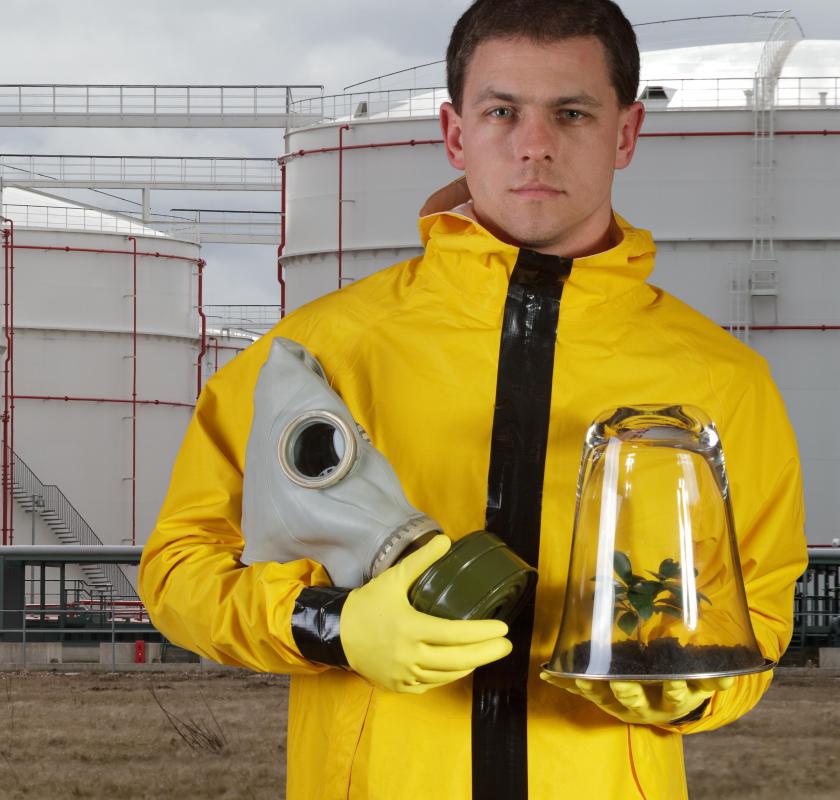At AllThingsNature, we're committed to delivering accurate, trustworthy information. Our expert-authored content is rigorously fact-checked and sourced from credible authorities. Discover how we uphold the highest standards in providing you with reliable knowledge.
What Is T-2 Mycotoxin?
Trichothecene mycotoxin (T-2) is a poison produced naturally by four different molds in the environment. It can be used as a biological weapon when mixed with chemicals, heated, and released into the air as an aerosol. T-2 mycotoxin use as a weapon might have occurred in Laos, Kampuchea, and Afghanistan in the 1970s and early 1980s, but controversy exists over these reports. Called yellow rain, this toxin quickly affects bone marrow, cells, tissue, and muscle function after exposure.
T-2 mycotoxin is insoluble in water and must be mixed with methanol, propylene glycol, or ethanol to activate toxins. The fungi remain dormant until heated above 1,500°F (815.5°C) for a half-hour or more. This toxic solution can be released into the air via aircraft or other means.

Some historians believe T-2 mycotoxin killed more than 6,000 people in Laos between 1975 and 1981. In Kampuchea, approximately 1,000 deaths are linked to the poison between 1979 and 1981, and more than 3,000 died in Afghanistan during the same time. Most of the victims were civilians or guerilla forces in remote areas of these countries. The main evidence of these biological attacks comes from victims or witnesses who reported yellow clouds over the areas.

T-2 mycotoxin might be inhaled, come into contact with skin, or be ingested. Flour contaminated with the fungi was baked into bread in Russia after World War II and fed to civilians. They developed alimentary toxic aleukia, a condition marked by vomiting, diarrhea, and stomach pain. Some victims died after developing bleeding ulcers in the throat.
When the skin becomes contaminated, the poison causes immediate burning and blisters. As the chemical enters the bloodstream, the skin might turn black and begin shedding. Sores and redness might also appear, along with itching. If the substance gets into eyes, they typically water and become red within minutes. Vision might also blur.
The only available treatment involves removing the T-2 mycotoxin from contaminated skin and clothing. All affected areas should be washed with soap and water, and eyes should be flushed with a saline solution or plain, clean water. Clothing and any items that came into contact with it should be sealed in a plastic bag.
In severe cases, victims exposed to T-2 mycotoxin become weak and fall to the ground. These symptoms might appear immediately or take days to develop. The body might go into shock and the heart may stop. Reactions to the chemical depend on the length of exposure, the concentration of the toxin, and how contact occurred.
T-2 mycotoxin might be confused with mustard gas or ricin gas because there is no test to positively identify it. The fungi can only be confirmed by testing tissue of people who died after exposure. No vaccine can protect against exposure, but researchers continue to study the toxin. The only available precaution against poisoning involves protective clothing and breathing apparatuses. Charcoal might absorb some of the chemical if ingested.
_
Frequently Asked Questions
What is T-2 Mycotoxin?
T-2 Mycotoxin is a potent, naturally occurring toxin produced by certain species of Fusarium fungi. It's a type of trichothecene mycotoxin, which can contaminate crops like wheat, barley, oats, and maize. Exposure to T-2 can lead to severe health issues in humans and animals, including nausea, vomiting, skin irritation, and in extreme cases, immunosuppression and hemorrhaging.
How does T-2 Mycotoxin affect animals?
Animals exposed to T-2 Mycotoxin can suffer a range of adverse effects, such as feed refusal, weight loss, reduced fertility, and immune system suppression. In poultry, it can cause beak lesions and poor egg production. According to the USDA, T-2 can also lead to vomiting and fatal hemorrhaging in severe cases, particularly in swine.
What are the symptoms of T-2 Mycotoxin poisoning in humans?
Humans exposed to T-2 Mycotoxin may experience symptoms like skin irritation, mouth sores, diarrhea, dizziness, and headache. Ingesting high levels can lead to severe health issues, including bleeding, sepsis, and damage to the digestive tract. The World Health Organization has documented cases where exposure to high doses resulted in alimentary toxic aleukia, a potentially fatal condition.
How can T-2 Mycotoxin contamination be prevented?
Preventing T-2 Mycotoxin contamination involves controlling moisture levels in crops, as Fusarium fungi thrive in damp conditions. Proper storage, handling, and processing of grains are crucial. Crop rotation and the use of resistant plant varieties can also reduce the risk. The FAO recommends regular testing of grains to monitor and manage mycotoxin levels effectively.
Is there any treatment for T-2 Mycotoxin poisoning?
Treatment for T-2 Mycotoxin poisoning primarily focuses on supportive care to manage symptoms. Activated charcoal may be used to limit absorption in the gastrointestinal tract if exposure is recent. Long-term recovery involves avoiding further exposure and supportive therapies to help the body recover. No specific antidote exists, making prevention and early detection critical.
Are there regulations in place for T-2 Mycotoxin levels in food?
Yes, many countries have established regulations for permissible levels of T-2 Mycotoxin in food and feed to ensure safety. The European Union, for instance, has set maximum levels for T-2 and HT-2 toxins in cereals and cereal products. The Codex Alimentarius Commission, under the FAO and WHO, provides guidelines and codes of practice to prevent and reduce mycotoxin contamination globally.
AS FEATURED ON:
AS FEATURED ON:












Discuss this Article
Post your comments